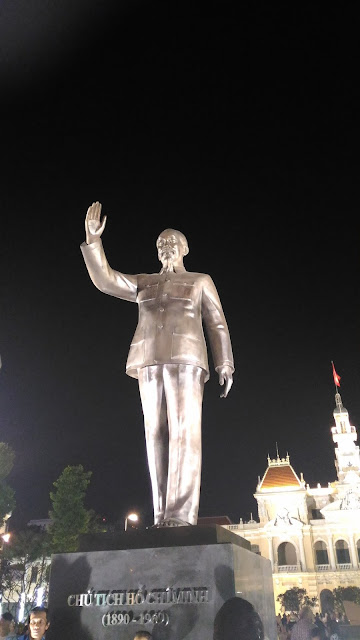Part 1 - Siem Reap
Part 2 - Ha Long Bay
Part 3 - Battambang
Part 4 (this blog) - Ho Chi Minh City
Part 5 - Sapa and Hanoi
Part 6 - Mekong Delta and Cu Chi Tunnels
This blog is more of a picture blog, as it was the most chill and least touristy part of our holiday. My dad stepped up to be our tour guide and just took us to random places, so there's not much to talk about here.
Lowlights:
Weather/Environment:
Accommodation: We stayed at my dad's apartment here, yay for free accommodation!
Overall:
There isn't too much to do here so I wouldn't spend too long in Ho Chi Minh City (aka Saigon, for the older people, or for those who do not want to refer to the place by its communist name), unless you wanted to focus on the food and shopping. It gives you a good understanding of Vietnamese culture, but there are more interesting places in the rest of the country.
Christmas Eve
We arrived Christmas morning, and so Christmas Eve was our very first night in Vietnam, and what a night to experience Vietnam! It was seriously INSANE the amount of people that come out to celebrate a Christmas holiday, considering Vietnam is not a Christian country.
Here we were thinking that this was just a typical night in Ho Chi Minh City, when even my dad is stunningly surprised, yelling out to us over the roar of motorcycles, "I have never seen anything like this! There are SO MANY motorcycles!"
We went to the Nguyen Hue Mall, which is an outdoor pedestrian strip in the heart of the city, and it was incredibly crowded.
We also had dinner at the Bitexco Financial Tower, which is the tallest building in Ho Chi Minh City. It was a cross between my belated birthday dinner and a Christmas Ever dinner, together with a "We are finally reunited with Papa Lim" dinner.
We had the buffet there, and it was pretty great, although we do believe that this may have been one of the sources of our food poisoning.
War Remnants Museum
The War Remnants Museum is arguably the thing that stood out to me the most on my visit to Ho Chi Minh City.
It has really cool displays of military equipment, ranging from planes, to weapons, to little personal belongings of soldiers, which was all pretty cool.
There is one section where they show the torturous tiger cages that the Americans used on their Vietnamese prisoners, which was horrific and terrifying.
Description: "Tiger cages" are in fact special cells for the detention of political prisoners considered "stubborn" by the Saigon authorities. There are 120 cages of such type in Con Dao Island. Each cell measures 2,70m x 1,50m x 3m. During the hot season about 5 to 14 prisoners were kept in one cell. In winter time there was only one of two of them kept in it with their feet shackled to a long iron bar. Eating, drinking, sleeping etc... are only allowed in this place.
Narrow passages were reserved to jailers who went back and forth and were ready to harass the prisoners. Talking, laughing, coughing, even slapping on mosquitoes might serve an excuse for the jailers to use violent measures against the detainees. They injured them with sharp sticks or shovel lime on them. A lot of prisoners received serious burns or vomited blood.
The detainees' meals consisted of handfuls of rice of very poor quality and small pieces of decayed dried fish. Vegetables and meat were definitely non-existent. Each prisoner was given half a tin can of drinking water a day let alone water for bathing or washing. The lack of water was really a punishment inflicted on women, specially during their menstrual days.
Prisoners' health got worse day after day. Obviously, casualties among the political prisoners kept in "Tiger cages" were high.
The most outstanding part of the museum, though, was the Agent Orange section, which was just a gallery of images of those affected by Agent Orange. It was so incredibly sad that I couldn't help but cry... a lot. In the end I just couldn't take it any longer and I had to go out and sit down, wiping my tears away.
Reunification Palace
The Reunification Palace was pretty cool too. The outside looks really incredible, and when you go in there's one floor where you can look out and have a stunning view from the balcony.
It's so called because this was the building where the communist North Vietnamese came to an agreement with the South Vietnamese people, thus reunifying the land. It's also sometimes called the Independence Palace.
Apart from that, the building isn't that amazing to look at; it's mainly just an exhibition of how all the rooms of the building look. It can be interesting since they're done up really formally and neatly, but many of the rooms look quite similar and you can get a bit tired of it. I did enjoy the private cinema room they had though (of course).
Miscellaneous





















No comments:
Post a Comment